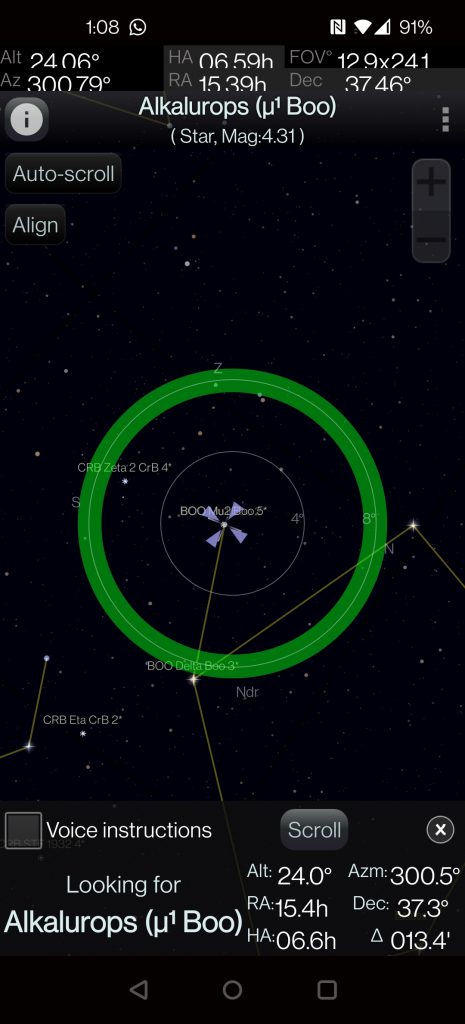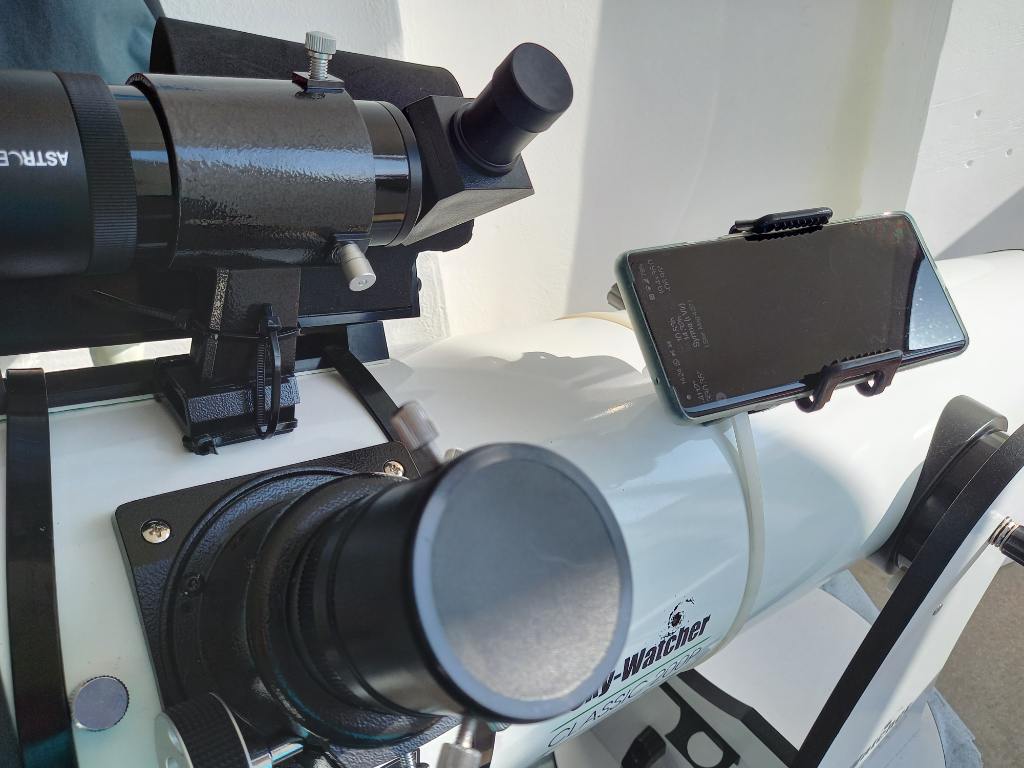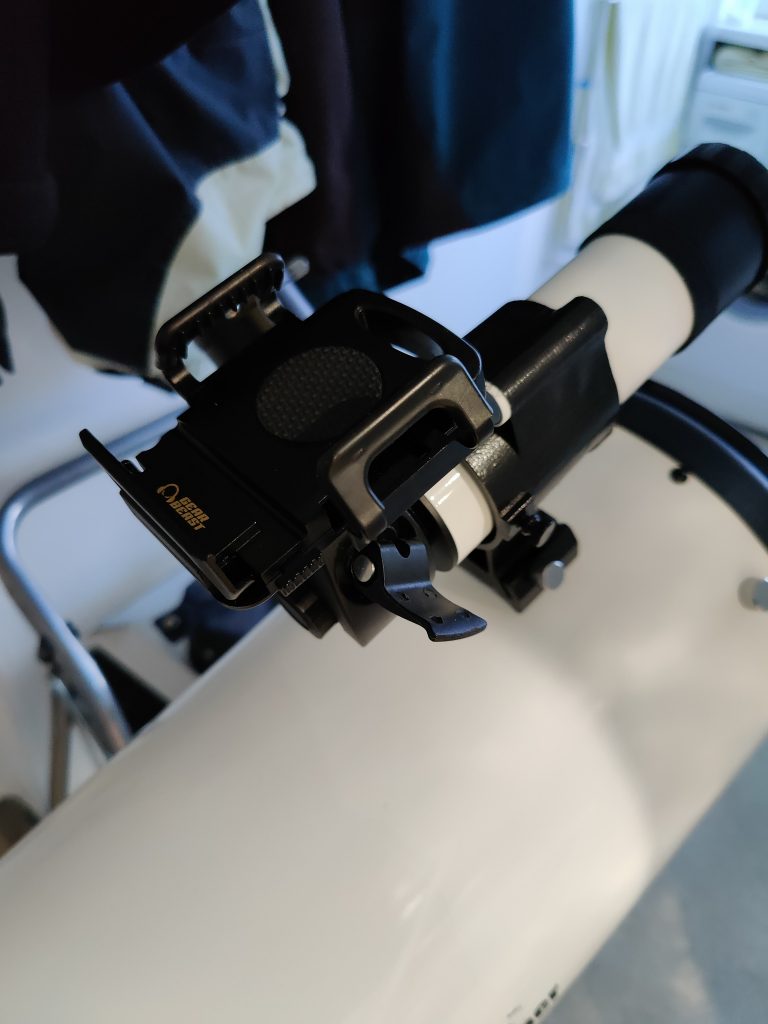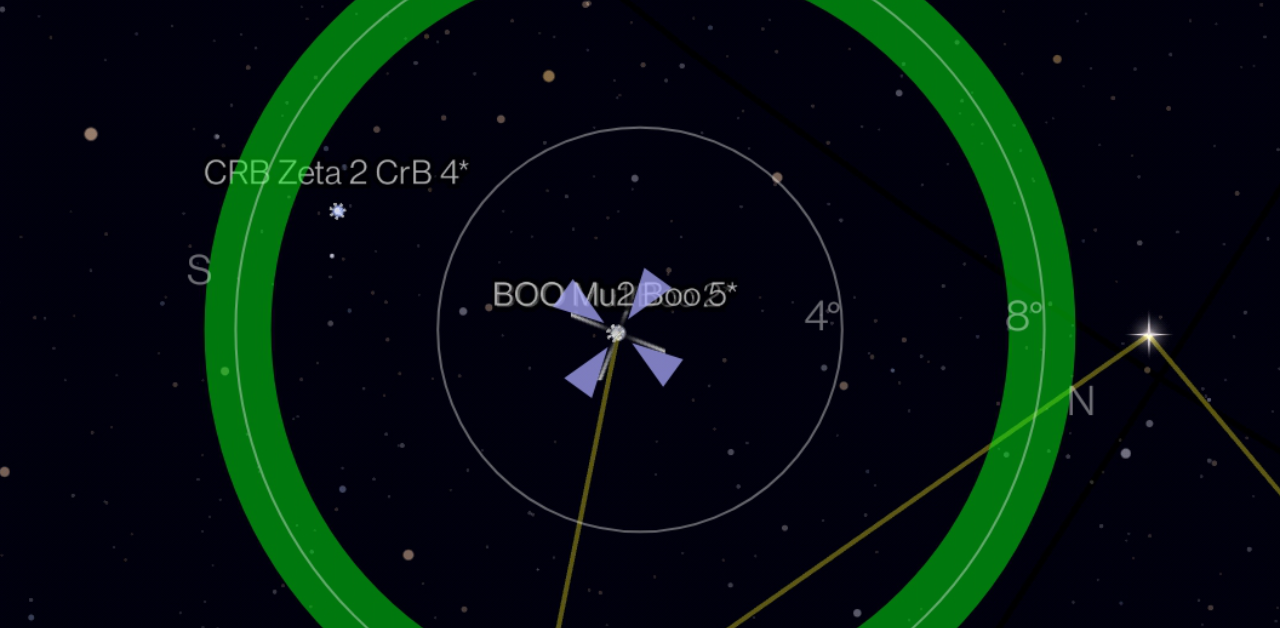
Push-to apps use the technology of a smart phone to guide you to targets.
Astrohopper is an open source web app that get good user views. It’s more accurate than SkEye.
SkEye is an app that like the excellent Stellarium allows you to find objects in the sky. It dispenses with ‘bells and whistles’ so there are no pretty constellation images but that functionality suits me fine. With a phone attached to the tube of my telescope, it also has the advantage of what is termed Indirect mode. Indirect mode allows me to locate objects using “push-to” so what I see on the screen is what I (should) see through the eyepiece.
I became more proficient in using SkEye to locate objects over time as I got to know its quirks and foibles.
For finding dim and difficult objects, I also use this method.
Key points
- I use a phone mount that I purchased for cycling. It used to be attached to the EP tube of my straight-through finder. As I now have a RACI, I attach the mount using a 1 metre cable tie.
- I have tried using the phone so that screen points upwards (as in the picture) and also towards the eyepiece (in landscape mode) so it is facing me. The latter makes scanning a bit of the sky to see what is there very easy. I have found a number of DSOs and binaries “by accident” in this way.
- The initial alignment was made using three easy to find objects. For example Arcturus, Mars, Castor and Polaris.
- After a period of use, I use the Insta-align function when I have acquired an object to improve accuracy.
- I still use the straight-through finder but not as often; so my back is grateful. I have a Telrad and use this to check that SkEye isn’t way off. The finder is used if an object doesn’t come into view of my WA 42mm EP.
- When I get dew or ice on my Telrad or finder, SkEye has been my only tool and has come to the rescue.
- The Telrad, finder, wide-angle (low power) eyepiece and SkyEye work together.
- SkyEye has its quirks. It can suddenly jump a few degrees but does seem to “find itself” again. I have not any stray magnetism warnings due to the metal OTA but this could be the cause of the jumping. User reviews indicate that
- Astrohopper doesn’t suffer the above limitations.
Update following a period of use
Alignment is very quick using a couple of good targets and then an insta-align “check” to keep things precise.
It can sometimes “forget where it is”, but a second later it catches up and it is often spot on target. I keep the magnetometer calibrated with a figure of 8 calibration. The author has an app for calibrating the magnetometer (instructions) and I find this works well.
I also tried using an old Samsung A3 phone rather than my main one (OnePlus 8 Pro) and although the screen is noticeably smaller it works fine once calibrated.
A major plus is that unlike my Telrad and finder scope it doesn’t suffer from dew or ice!
Given that the app was free, in order to support the developer (who offers brilliant support) I bought the Pro version (about £8) which has more objects and also allows me to add my own database of binary stars.
I’ve now changed the finder to a right angle type (RACI), so I now star hop to find objects as I find that method quick and efficient. This is particularly the case for galaxies and fainter nebulae.
If you are interested in using technology to find objects
, I’d recommend looking at Astrohopper as well as SkEye.

More details
https://artyom-beilis.github.io/astrohopper.html
https://lavadip.com/skeye/index.html
https://lavadip.com/skeye/book
https://lavadip.com/skeye/media/v0_skeye_user_manual.html



I’d like to know more info on why your dob needs to be on a level surface to use this app. I know that sounds logical, but when I used to use my old NGC max digital setting circles on my 22 inch inch dob, all you had to do to start was point the scope straight up and hit “vertical” as a command to the unit. It didn’t matter if your scope was on an incline because the computer was using the info on the positions of your two guide starts to determine the angle of your target.
Maybe this system is different, but I’d like to know if you encountered issues where it wouldn’t work correctly because your scope was on an incline. Primarily because my observing site is on a slight hill on very lumpy ground.
I would love to use this system with my ten and 22 inch dobsonians.
Given that SkEye uses the phone to identify position, you are correct that other than for reasons of stability, there is no need for the base to be horizontal. I have updated the post accordingly. Thank you for the feedback.
Thanks, Bret!
I saw your comment on Reddit and this review helps. I’m stuck between getting a Go-To and Dobsonian, and this may seal the deal on getting a Dobsonian.
Glad to have helped – thank you for the feedback.
Thanks Paul. I think finding objects yourself is fun and actually quicker than having to set up a computerised mount.
Great info very informative. The cable tie idea is great. I’ve recently been looking for a method of attaching the Starsense explorer dock onto my Dob. This I think is what I’ll be doing I can leave my little scope as is for my son. Get some cable ties and this app and I’m good to go don’t have to mess with my Dob with screw holes or double sided tape etc
Thanks for the feedback Mick and good luck with the project.
Hi Mick and Brett,
I am the author of the SkEye app, and was delighted to find this review today! I know SkEye has its foibles and I am trying to hack at them, slowly and surely 🙂
In the meanwhile, I have been also developing a camera based app, which you can try from here: https://play.google.com/store/apps/details?id=com.lavadip.skeyecam
If anything, this app has even more foibles as it’s still early in development, but I was lucky to get a few clear nights with it last week, and I was very happy with the accuracy, if I say so myself. With just a single alignment on a terrestrial object, I found M2 and M15 right in the middle of my eyepiece view within minutes.
It will still take a couple of months to improve the UI, add more objects to the database, etc. But as a concept, it works great already!
Note that the camera needs a clear line of sight, so you might have to mount the phone differently than what is pictured here.
Great Post I will check the SkyEye. Meanwhile I also came across the astrohopper app opensource. What has your opinion about this?
I’ve not used the Astrohopper app so I cannot comment. I’d recommend asking on the StarGazers Lounge or Cloudy Nights forums